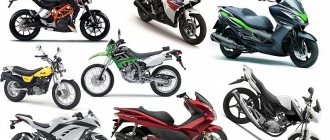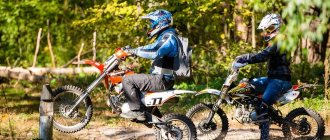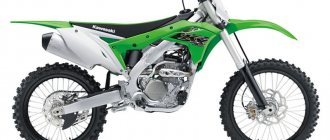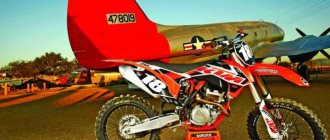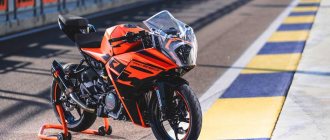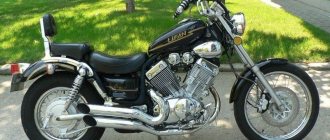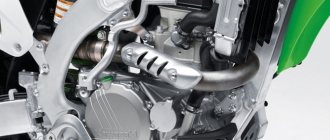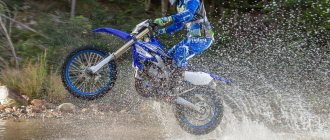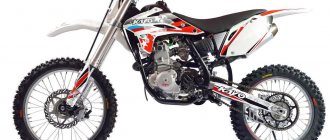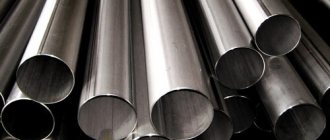Updated article from: 12/03/2020
For fans of motorcycles, various types of vehicles are produced, developed for specific purposes and conditions of use. For long trips and travel, manufacturers create touring cruiser bikes. Motocross motorcycles are perfect for motorsports and competitions on prepared tracks. Enduro bikes are adapted to overcome difficult routes. A separate category includes mini-motorcycles of the cross-enduro type - pit bikes.
Motor vehicles impress with the variety of road and racing models, tourers and choppers, dragsters and cruisers. The classification of bikes is quite arbitrary - many models combine features of several classes, and even within one type there are highly specialized subtypes. Therefore, it can be difficult to visually determine the class of a bike. Next, we will look at the differences between pit bikes and motocross motorcycles.
Pitbikes
Pit bikes can be considered a fairly new type of transport, because they appeared only in the middle of the 20th century and were used to travel between pit boxes during races. Today, the mini-motorcycle has become a separate branch of the motorcycle industry.
Among the main distinguishing characteristics are very small dimensions and a small size of a powerful motor. Depending on the future owner, engineers have developed various engine models with power from 50 to 250 hp. With.
Pit bikes were originally made for off-road racing. You shouldn’t expect great speed from them, but they are more affordable and lightweight compared to cross motorcycles.
So there is always a range of equipment for both adults and children.
Everyone was faced with the problem of choice and always started by searching for information. So which pit bike is better?
For learning fundamentals and motocross
This device attracts with its lightness and simplicity of design and is perfect for a beginner to learn motocross as a first vehicle.
You can ride a pit bike all year round.
Due to the diversity of the model market, adults can purchase interesting models with an average engine capacity of 125 liters. With. for an amount less than 50 thousand rubles. For comfortable operation, it’s worth looking at models with a semi-automatic transmission, but this pleasure will cost 10 thousand rubles. expensive.
The entire range of products can be divided into five conditional groups:
A children's pit bike will be a good option for getting acquainted with motor vehicles.
The Regulmoto 125 pit bike is equipped with an engine with a power of less than 9 hp.
Mikilon 160PRO cross-country pit bike with a 17 hp four-stroke engine. – quite a serious unit for participation in competitions.
Irbis 125 TTR
For comparison, we will take the IRBIS ttr 125 pit bike, which is very popular in RUSSIA. It has already had a restyling. He purchased a headlight and an hour meter. More or less reliable technology. It is in no way inferior to our RegulMOTO.
Source
The most popular pit bikes in Russia
Due to the high cost and various difficulties in purchasing pit bikes from large concerns, the most popular in Russia are motorcycles from manufacturers such as YCF (France, assembled in China), BSE (Russia, assembled in China), KAYO (China), JMC (Russia, assembled in China) and Apollo (China).
Pitbike Apollo RFZ Elite 150 14/12
Pit bike Kayo KRZ 125 17/14
Motorcycles of these brands can be described as “the highest quality among budget solutions,” and such equipment is quite suitable for both amateur riding and basic training, as well as for participation in various competitions.
Rules for pit bike/minimotocross competitions, technical regulations and requirements for tracks
1. COMPETITION RULES AND REQUIREMENTS FOR TRACKS. 1. Definitions. 1.1. Minimotocross is a competition on special motorcycles, held off public roads on a closed track with natural obstacles. 1.2. Minisupercross (arenacross) is a minimotocross held at an open-air or indoor stadium on a cross-country track using only natural materials (sand, earth, etc.).
2. Motorcycles. 2.1. Allowed to participate in competitions are 4-stroke motorcycles, air or air-oil cooled - singles that have passed technical control, engine cubic capacity in accordance with the requirements of the sports code, which is indicated in the Regulations for each discipline. 2.2. Competitions may be held in one or more single motorcycle classes. 2.3. In winter minimotocross/minisupercross competitions, the use of metal spikes is permitted, which must be indicated in the competition regulations. Participation in one race of motorcycles with studded and non-studded tires is prohibited.
3. Participants. 3.1. Athletes by gender, age and qualifications are allowed to compete in accordance with the requirements, as specified in the Regulations for each discipline. 3.2. Athletes who have reached 40 years of age and older may be allowed to participate in competitions on the basis of a certificate from a medical and physical education clinic about their state of health and a conclusion on fitness to participate in competitions and only if they have an electrocardiogram with a positive doctor’s conclusion. The validity period of the document is determined by the organization that issued it.
5. The nature of the competition. 5.1. According to the nature of the competition, competitions can be: personal and divided into single-stage and multi-stage. 5.2. Depending on the rank of the competition, the number of participants, motorcycle classes and other conditions, the number and duration of races in each motorcycle class and each group of participants is established, as indicated in the Competition Regulations.
6. Regulations on the competition. 6.1. The organizer is obliged to provide participants with the Regulations on the competition, containing all the necessary information about it. In accordance with the deadlines specified in the Regulations, each athlete (team) must submit its preliminary application to the organizer.
7. Route. 7.1. The minimotocross track can be stationary (permanent) or temporary and should be constructed only from natural materials (earth, sand, etc.). The marking and execution of the route must be based primarily on the safety of the athletes. The length of the route must be at least 500 m and no more than 1 km. The width of the track at its narrowest point should not be less than 3 m. The recommended (optimal) width of the track at its narrowest point is at least 5 m. The minimum width of the track at the first turn after the start should be about 8 m. The track should not fork anywhere, however , during training, it is allowed to use bales of compressed straw in a plastic shell to create additional paths on the turn. The free vertical space between the track and any obstacle rising above it must be at least 3 m. 7.2. To ensure the safety of athletes, special attention should be paid to the springboards and their configuration. In the landing area after the jump, the width of the track should be at least one meter wider than in the take-off area. Multiple jumps are not allowed. They are considered jumps when the second and/or third hump is in the landing zone of the next hump. Sections of the “comb” type route are prohibited. Sections of the route with a wavy track (unevenness) can be included in the route. The distance between the peaks of wave-shaped springboards should be about 10 m. The height of each of them is limited to 80 cm. The take-off (take-off) and landing zone of these obstacles must be made and tested by highly qualified athletes. 7.3. A course cannot be approved if it is in deep water, is very rocky or rocky, or contains straight sections that allow excessive speeds. It must be done in such a way that the average speed in the race does not exceed 55 km/h. 7.4. The mini-supercross track can be stationary (permanent) or temporary, outdoors or under a roof, and must be constructed only from natural materials (earth, sand, clay, etc., without stones). On open-air routes, special attention should be paid to draining water from low-lying areas. The length of the track outdoors must be at least 300 m, indoors - at least 200 m. The width of the track at its narrowest point is at least 3 m and there should be no sharp narrowings or bifurcations. In the landing area after the jump, the width should be at least one meter wider than in the take-off area. The free vertical space between the track and any obstacle rising above it must be at least 3 m. 7.5. In accordance with the route map, all sections must be numbered. More details here.
This is a small, lightweight motorcycle that looks like an off-road cross-country unit. It has a 4-stroke engine and wheels with sizes of 10, 12, 14 and 17 inches. They are produced by many motorcycle manufacturers, both world leaders and smaller companies. Today you can buy it in almost every more or less large city from official dealers of companies.
Mini motorcycles of this type are suitable for people weighing up to 100 kg. To make it comfortable to drive, it is equipped with a reinforced frame, extended wheelbase, reinforced suspension, high handlebars, etc. However, it remains an oversized bike, which makes it a real pleasure to ride. The fuel used is 92nd or 93rd grade gasoline, which is simply poured into the gas tank. There is no need to add or mix oil with additives into gasoline, which also simplifies the preparation of the bike for travel and operation.
The main questions are: how to ride and where?
Country - movement over rough terrain. 10-17-inch wheels with off-road tread are suitable for this. Country skiing is the most popular type of skiing. The main thing is to protect the rider.
Motocross. Any tracks and jumps for riding and jumping are suitable for this. Wheels must be 14/12 or 17/14 inches equipped with off-road tires. All attention is paid to the safety of the rider.
Supermoto involves riding on any flat surface. Karting track or special tracks for Supermoto are perfect for this. Wheels can be 12/12 or 14/14 inches, and Slick tires provide good grip.
Stunt is one of the most popular disciplines. Any area with a smooth, high-quality surface is suitable for it. Involves performing various stunts and basic aerobatics in motorsports. For best results, use pegs and yokes.
The park is a fairly new area that involves tricks and figures. You can ride in Skate and BMX parks, specially created for this purpose. A pit bike in this discipline weighs quite a bit. Wheels with road tires should be 12/12 inches. Motorcycle protection is provided by pegs and sliders.
Freestyle motocross is also a new discipline. These are dizzying jumps from springboards, performing acrobatic stunts in flight. But this is also the most dangerous direction.
Street is driving around the city without rules and restrictions. Various tricks are performed on obstacles. Obstacles include stairs, curbs, walls, cars—any objects protruding or rising above the asphalt. Motorcycle protection is provided with pegs, yokes, and sliders. But this discipline is prohibited because it is dangerous for the drivers themselves and others.
There is a question that interests both the owners of a new pit bike and those who are just planning to buy one: is it dangerous? Riding a minibike is safe if you don’t forget about protection and use common sense rather than passion. If you do the opposite, then not only a motorcycle, but also a bicycle, but also a scooter will become dangerous.
It has a simple, but at the same time reliable design, the operation of which does not require the driver to have special knowledge or certain skills.
In order for the bike to serve you for a long time and not cause any complaints, you need to properly break it in and monitor the condition of the parts and components. Attention should be paid to the quality of movement from the first ride until the completion of the first 35 motorcycle hours.
During break-in, pay attention to the engine. In order to continue to enjoy a good and fast ride, you first need to be patient. Carefully monitor the oil level in the engine using the dipstick. When checking, the motorcycle must be level, otherwise the indicator will be overestimated or underestimated. Unscrew the dipstick, wipe it with a clean cloth, insert it back without screwing it in, then take it out again and look.
The oil level can also be checked on a “hot engine”. After turning off the engine, you need to wait a couple of minutes and then take measurements.
When running the motorcycle for the first 35 hours, strictly ensure that the engine does not overheat. When starting a cold engine, wait until it warms up (approximately 2 minutes).
To make the run-in as effective as possible, follow the recommendations. Avoid sudden and heavy loads on the engine and clutch. Do not ride for a long time at low speeds, pick up speed smoothly. When changing speeds, avoid jolts and jerks, change gear modes smoothly. On each subsequent trip, if the break-in was done correctly, the gearbox will work more clearly, and gear shifting will become more confident. To ensure the engine lasts longer, the oil should be changed twice during break-in: after 18 and 35 hours of operation.
Pitbike
is a type of motorcycle aimed at fans of
mini-motocross
or
mini-supermoto
, as well as
beginner motorcyclists
.
Minimized geometry, small wheels, a predominantly 4-stroke engine with a relatively small cubic capacity allow you to learn how to control a motorcycle, change gears, feel the clutch, recognize the surface and brake correctly without putting any serious strain on the rider. A relatively safe
,
affordable
,
easy-to-use
pit bike allows you to get an idea of large-size motorcycles and their power, thereby helping those who want to start motorsports, but who doubt the right choice, relieving them of unnecessary hassle with a full-size motorcycle.
Pit bike
is a small introduction to the big sport.
Pitbikes
(Pitbike) came to us from the USA.
The first ancestors of modern pit bikes were small bicycles with a 2-stroke engine with a capacity of up to 49 cm3.
, developing power 3 - 5 hp.
Motorcycles for motocross did not have any technical sophistication; even the brakes and suspension necessary by today’s standards were simply absent. “Pits” were intended for the movement of racers and team personnel in pit stops (pit stop is a technical area where racing equipment undergoes final preparation for competitions, hence the name). Years passed, and as they gained mass popularity, pit bikes began to be equipped with larger and more powerful engines
(110-160 cc, 12-16 hp),
hydraulic suspension
,
aluminum frames
,
disc brakes
, etc. So, thanks to the interest of “riders” to race literally everything that rides and has a motor, pit bikes quickly evolved into full-fledged mini-cross motorcycles, like those used by adult factory teams.
Pit bikes today
- entertainment for people of all ages.
Racers compete against each other for fun, on small makeshift tracks. A pit bike does not need huge territories; a small area for a track is enough. Pitbike does not require large financial investments.
The Pit bike is incredibly versatile and can be easily and quickly modified to suit any class of motorcycle.
Motocross, stuntriding, track, enduro, mini-motard, supermoto, minimoto - it's all a pit bike!
Also,
a pit bike is an excellent trainer
for both beginners and experienced riders to hone their skills. Cut laps on the track, perform difficult stunts, knead mud, rock along forest paths - give yourself a lot of fun and excitement with your pit bike! “The pit bike is just a plague,” as the fans themselves say. “Pitbike is a disease!”
What is a Pitbike?
Pitbike - A pitbike is a motorcycle that is often similar in appearance to a cross-country off-road motorcycle, but with a smaller size and weight. Pitbike - four-stroke engine, wheels 10, 12, 14 and 17 inches.
Who is the manufacturer?
PITSTER PRO USA MOTORTOYS LLC 25 North 1400 West Unit A Lindon, Utah, is a world leader offering the highest quality and competitive Pitbikes in the US and European markets. Over the past 5 years, Pitster Pro has been actively expanding its dealer network throughout the world. Today Pitster Pro has more than ten international dealers in many countries around the world. Assembly of motorcycles in China. The quality is very high. The Pitmoto company is the exclusive dealer of Pitster Pro USA in Russia.
For whom?
If your weight is up to 100 kg, with a level landing on the motorcycle, your both legs reach the ground - That means it’s for you! For more convenient control, the wheelbase has been increased, the frame has been strengthened, the suspension has been made more reliable, the steering wheel has been high and much more. But at the same time, the Pitbike remains a small motorcycle, which makes riding it an endless pleasure!
What to fill with?
Gasoline AI-92-93. The fuel is poured directly into the gas tank, and that's it. There is no need to add or mix oil or additives into the fuel.
Where and how to ride?
Pitbike Country
travel over any rough terrain, at any time of the year. This is the most popular and widespread discipline. Wheels ranging in size from 10 to 17 inches, with off-road tread. Attention to rider protection.
Pitbike Motocross
Motocross tracks and jumps of all levels, everything for active riding and jumping. It is advisable to use 14/12 or 17/14 inch wheels with off-road tires. Attention to rider protection.
Pitbike Supermoto riding on any flat surface. Kart track or Supermoto tracks are ideal. The most common wheel sizes are 12/12 and 14/14 inches, and for better traction on the track, tires are Slick.
Pitbike Stunt
too, is one of the most popular disciplines. Any area with good and even surface is suitable. You are expected to perform stunts and basic aerobatic maneuvers. It is recommended to use pegs and yokes.
Pitbike Park
is perhaps the newest discipline. Riding in prepared Skate and BMX parks. Various figures and tricks are performed. In this discipline, the weight of the Pitbike is reduced as much as possible. The main wheel size is 12/12 inches, with road tires. To protect the motorcycle, it is recommended to use pegs and sliders.
Pitbike Motofreestyle
Another new discipline. These are incredible jumps from special springboards, and performing various stunts with acrobatic elements in flight. Attention - the most dangerous discipline!
Pitbike Street
Street driving without any rules or restrictions in the city! You are supposed to ride and perform tricks over any obstacles on your way. Obstacles can include stairs, ledges, curbs, walls, underpasses, cars... basically anything in the urban jungle. Also, to protect the Pitbike, pegs and yoke sliders are recommended. Attention - discipline is illegal! This style of riding is extremely dangerous for the rider and others.
Is a pit bike safe?
Yes, it is safe if you use common sense and do not neglect protection. But, if you are very, very scared, there is always good old chess and checkers: Read more about safety here.
How reliable is it?
Pitbuy is a simple and reliable design that does not require special knowledge and skills from you. For long-term operation of your Pitbike, it is important to properly break in and in the future regularly monitor the technical condition of the motorcycle.
Running in a Pitbike
Proper running-in of the Pitbike is the key to its long-term operation in the future, so special attention should be paid to the correct operation of the Pitbike from the first day, until the first 35 motorcycle hours have passed.
Running in the Engine
Particular attention should be paid to the engine! It is important to pay close attention to the engine when breaking in a new Pitbike. Very soon you will be able to enjoy the full resource and capabilities of the engine, be patient. Carefully monitor the engine oil level using the dipstick. To check the oil level, the Pitbike must be in a level position! Unscrew the dipstick, wipe the dipstick with a clean cloth, then reinsert the dipstick without screwing it in, remove it again and check the level. To check the level on a “hot engine”, turn off the engine and let it burn for 2 minutes. During the first 35 hours of operation, do not allow the engine to overheat! After starting a cold engine, wait until the engine warms up (2-3 minutes).
1 Avoid sudden and maximum loads on the engine and clutch during break-in mode.
2 Avoid long periods of driving at low speeds.
3 Accelerate smoothly.
4 Be careful when changing gears, avoid jerks and jolts. change gear modes using smooth movements.
5 With each new trip, with proper break-in, the gearbox will work more clearly and gear shifting will be more distinct and confident.
For long engine life, we recommend changing the oil twice during break-in: After 18 and 35 operating hours of the Pitbike.
Delivery
Motorcycle delivery in Moscow and the Moscow Region is carried out by our own delivery service. Motorcycles are delivered throughout Moscow and the Moscow Region, assembled and in working condition (without factory packaging). In Russia, motorcycles are shipped in a protective metal frame and original factory packaging. We organize delivery throughout Russia together with large Russian transport companies. The cost of delivery of Pitbikes across Russia is in the Delivery section.
Spare parts
You can buy in our store, see Contacts. Delivery by courier is also possible. Delivery to the regions with EMS Russian Post. You receive and pay for the ordered spare part at the post office nearest to you.
Pitbike vs motorcycle: which is better to choose, what are the differences?
The word “motorcycle” combines a huge number of two-wheeled vehicles, which are divided into several large categories.
The lightest and most compact motorcycle is the pit bike. Sporty in design, small in size, it attracts many lovers of two-wheeled vehicles, but at the same time it has many features.
We will tell you exactly how it differs from a “regular” motorcycle, and who should choose it and when.
Engine
Pitbike. The engine is air or air-oil cooled and has a carburetor fuel supply system. There is one cylinder and is usually located horizontally. The volume can be from 49 to 190 cm³, but the majority of such equipment is equipped with a 125 cc engine.
Motorbike. The engine is air, air-oil or liquid cooled. The fuel supply system is carburetor or injection. There can be from one to six cylinders. On boxer engines they are located horizontally, on others they are usually vertical. The volume varies from 50-125 cm³ on “small-capacity” models and up to 2000 cm³ on tourist models.
Differences in the purpose, status and design of a pit bike and a motorcycle
The most important difference: a pit bike is not a vehicle, but a sports equipment. And this means that:
The pit bike itself is a lightweight mini-motorcycle, previously used to service racing motorcycles in competitions to quickly move around the track. But later, in the 1970s, it was separated into a separate class of equipment, and is now used for several types of sports disciplines:
And even later, pit bikes for enduro and motocross began to be produced separately. For enduro they are made more all-terrain, and for motocross they have a larger wheel diameter.
What to choose in the end
After reviewing the presented and similar materials on the topic, as well as based on personal preferences, you can successfully select a good model of motorcycle equipment:
- a pit bike is more suitable for novice drivers, while an ATV is more quickly mastered by experienced drivers;
- a pit bike is more mobile than an ATV, several times cheaper, consumes much less fuel, but is inferior to it in terms of cross-country ability;
- riding an ATV is much more comfortable - after all, it has four legs, and not two, like a pit bike, and besides, the narrow saddle of a mini-motorcycle is inferior in comfort to the wide seat of an all-terrain vehicle.
When comparing a pit bike and an ATV, it’s difficult to say which is better. First of all, it all depends on the preferences of the rider and the purposes for which the vehicle is purchased.
Technical differences between a pit bike and a motorcycle
Dimensions
The first thing that catches your eye is the size: pit bikes are much smaller. On average the dimensions are:
| Parameter | 125 cc pit bikes | 250 cc pit bikes | CFMOTO 250 NK (ABS) |
| Length, cm | 155-170 | 185-210 | 199 |
| Handlebar width, cm | 75-80 | 75-80 | 78 |
| Height, cm | 80-100 | 95-110 | 107 |
| Wheelbase, cm | 110-120 | 130-150 | 136 |
| Weight, kg | 65-80 | 110-115 | 151 |
| Ground clearance, cm | 20-22 | 25-28 | 15 |
As you can see, even powerful 250 cc pit bikes, almost comparable in size to a compact motorcycle, weigh less and have much greater ground clearance. Well, the more common pit bikes with engines of 125-150 cc will differ in size.
Among other important things: low weight is a plus for “mud” transport. Even if you get stuck, you can easily pull it out even alone. And its small dimensions simplify transportation - to get to the track, a pit bike with the wheel removed can even fit into the trunk of a crossover, station wagon or large hatchback with the rear seats folded down.
Engine, power, speed
Children's and teenage pit bikes usually have 50-100 cc engines with a power of about 2-3 “horses”. For 125 and 150 cc models, the power is usually 8-15 hp, which is enough to accelerate to 90-100 km/h on a straight, flat road. And the most powerful 250 cc engines can produce 17-21 hp.
For comparison: a 250 cc motorcycle has an average power of about 25-30 hp, and a 125 cc motorcycle has about 12-15.
Among other “engine” nuances, pit bikes usually have a muffler with a large exhaust hole diameter. It sounds very loud when revving up.
Controllability
In terms of handling, a pit bike is something between a motorcycle and a bicycle, but there are a couple of features:
What is the result: a pit bike steers more sensitively and reacts to steering wheel turns much sharper than motorcycles and scooters.
Wheels
Pit bikes have small wheels - their diameter can be from 12 to 18 inches in the rear and from 14 to 21 inches in the front. Typically, classic pit bikes (without a cross bias) have wheels with a diameter of up to 14/17 inches.
This is done in favor of cross-country ability and dynamics: small wheels weigh less and also allow you to accelerate much faster.
Suspension
Since pit bikes are designed for jumps, jumps, and simply off-road with holes and bumps, they have increased suspension travel: usually 25-30 cm. The suspension itself is also simple: a monoshock absorber at the rear, an inverted fork at the front. They react very sensitively to impacts in order to absorb them upon landing.
Starter
Often, especially in budget models, a kickstarter is installed instead of an electric starter. This not only makes the pit bike cheaper, but also makes it lighter - since you can do without a battery.
The first motorcycle for my uncle at 32 years old, and which one did I choose?
I decided to make my first post. The purpose of this opus is to talk about the agony of choosing the FIRST
motorcycle for my uncle at
32 years old
. What, how, why and how much!
So, I'm soon 32 years old
, and I decided to give myself a small present. As a child, like most boys, I wanted something with two wheels and a motor. But somehow it didn’t work out, my dad forbade it, and apparently I didn’t really want to.
So what do we have? There are no licenses of category A, there are no M licenses or anything else. There is only V. For a moped you already need at least M, but up to 50 cubic meters it seems that V will do, but I’m not sure.
I started browsing message boards, created a search, and received notifications by email. I was interested in the price range up to 30,000 rubles, ideally even cheaper, because the house is being renovated, my wife and I sleep on the sofa, and she, my beloved woman, won’t understand why the hell I locked a TYRCHIK home instead of a bed.
What is a pit bike?
A pit bike is one of the subtypes of a motorcycle. It is suitable for motocross enthusiasts. Many people recommend a pit bike for those just learning to ride a motorcycle, including teenagers.
Characteristic features for this vehicle:
A pit bike is easier to control than a motorcycle. It is considered a safe and cheap option. This vehicle allows you to experience motorsports without the hassles of a full-size motorcycle.
The pit bike has evolved from a regular bicycle to a simplified small-sized motorcycle. In translation, the meaning of the word “pitbike” stands for “bicycle for technical boxing.”
Previously, pit bikes were a type of bicycle used as transport for movement, as well as for racers in the pit lane. Despite the transformation of the pit bike, the name remained the same. A smaller version of the motorcycle appeared in the 50s of the 20th century in the United States. Characteristic differences were small dimensions, high speed and maneuverability.
Design features and technical parameters
Scooters are generally lighter in weight and size. The comparison is quite simple. If the weight of a motorbike is 200 kilograms or more, some scooter models do not reach the 70 kilogram mark.
When designing new scooter models, alloy wheels with a diameter of eight to fifteen inches are used. This is less than in a full-fledged motorcycle.
The motorcycle power unit is installed between the front and rear wheels. Rotational force is transmitted from the engine through a driveshaft or chain, reaching the rear wheel. In scooters, the motor is placed closer to the rear wheel. The reason for this is the need to transmit rotation directly without using additional lines. Vehicle stability is also ensured due to the lower installation of the power unit.
There are also significant differences in fuel consumption. A full-fledged bike requires 10 liters of fuel per hundred kilometers, while a scooter consumes 5 times less volume. Gears are changed on the motorcycle using the left lever by pressing it with your hand, while simultaneously pressing the pedal with your right foot. The scooter is equipped with a variator or automatic transmission. Operation control is possible thanks to a lever installed on the right side of the steering wheel.
You can brake the bike using the foot pedal installed on the right side of the vehicle. In this case, the pedal is responsible only for the rear brake. To also engage the front wheel, you need to use the right brake lever on the steering wheel. Since scooters have no clutch, the braking process is comparable to stopping on a regular mountain bike - you just need to press the handles with both hands to reduce the speed of rotation of a pair of wheels.
On scooters, the seating position is comfortable for the driver; the feet are placed on a special platform under the steering wheel. The design provides protection for the feet from constant ingress of water/dirt. When riding a motorcycle, the driver has to place his feet on the sides, while moving them closer to the rear of the vehicle. The body leans forward. This was done not only for additional convenience, but also to improve aerodynamic properties when driving at high speed.
Scooter parts and components are covered with casing elements made of impact-resistant plastic. The scooter does not have a license plate. It is also not necessary to register the equipment with the traffic police. This rule applies only to those vehicles that have an engine capacity of no more than 50 cubic centimeters. Of course, a 150cc scooter will already have to be registered. There is a spacious trunk under the seat. To prevent intruders from stealing personal belongings, it is locked.
Selection options
The invention of the last century was ahead of its time. The reason was the use of a four-stroke engine, as well as the fact that the cylinder began to be positioned horizontally.
There are several types of pit bike depending on the wheel size: from 10 to 21 inches. The smaller version of the motorcycle is meant to be used by an adult; for this purpose, the vehicle has an extended wheelbase.
Modern pit bikes have three types of gear shift systems:
For beginners, the best option would be an automatic transmission system.
Selection by height
The selection rules for this criterion are as follows:
To choose the right vehicle, you should divide your height by 2: the resulting value is optimal for the height of the saddle. If you have the opportunity to sit on a pit bike, it is recommended to make sure that your lower limbs do not touch the handlebars before purchasing. There should be no discomfort due to landing when maneuvering.
The frame is considered the main element of a pit bike. There are several types of frames.
It is possible to make a custom frame to suit individual requirements. Frames are often made of steel, due to the low cost of this material.
Engine
When choosing a pit bike, you should pay attention to the engine types.
The highest quality option is YX. It can handle heavy loads and is suitable for cross-country running. It is characterized by good endurance, is undemanding in repairs, and spare parts are easy to find. Maintenance will not force you to spend a lot of money.
Some engines have a semi-automatic gear shift system. Gear changes are done manually, but the clutch does not need to be depressed. The spring automatically selects it, the driver only has to change the speed in a timely manner. It is considered a convenient option for beginners. Such a system is characterized by a high degree of reliability.
You should not buy pit bikes that have engines with electric start, as they break down much more often and the battery drains faster. Difficulties arise in finding spare parts when servicing and repairing the engine.
For children, the best option is to buy pit bikes with a capacity of no more than 125 cubic meters. They are much easier to start. Models with a semi-automatic gear shift system are in great demand.
For teenagers, experts advise purchasing pit bikes with a capacity of up to 500 cubic meters. They can be suitable for adults too. It is considered the golden mean of all possible options. The engine is capable of producing up to 16 horsepower.
Professional pit bikes with a capacity of 1500 cubic meters or more are characterized by a high monetary value. From such motorcycles jumps from a height of ten meters are allowed. The engines do not have electric start.
Wheels and steering wheel
In budget versions of the vehicle, the steering wheel is made of steel. It is characterized by heavy weight and the need for frequent repairs and maintenance.
The best quality option is an aluminum steering wheel, which is characterized by strength and the ability to straighten out after a fall. Pit bikes with such handlebars are more expensive.
Particular attention should be paid to the tires of the pit bike wheels. The cross variety is used only for ground coverings. If you drive on an asphalt road, they will quickly wear out. When traveling on asphalt, it is recommended to purchase road tires.
For training, it is recommended to use wheels no larger than 14 inches. This is a universal option for the track. Due to its high strength and small diameter, it achieves a comfortable ride for drivers of average height.
The classic option is 10 and 12 inch wheels. The maximum permissible weight is 100 kilograms. Wheels of 17 inches and larger are intended for driving a pit bike by a tall person, for riding in forests or fields.
Shock absorber
Adjustable shock-absorbing elements are mounted on expensive types of pit bikes. Budget versions of mini motorcycles are characterized by simple equipment. The last option is recommended for beginners.
Technical features of modern pit bikes
Nowadays, a huge number of different models of pit bikes are produced, and the number of manufacturers is not far behind, due to the fact that most of the companies are Chinese brands, both quite large and little-known.
Many European and domestic manufacturers also manufacture key components and assemble their pit bikes in China. Only large Japanese concerns that produce “big bikes” for motocross stand apart in this situation. However, due to the small range of models in the lines of well-known brands, it is Chinese equipment that is most popular among buyers, including due to its high availability and relatively low retail cost.
Of course, the quality of these products does not always “cause delight” during intended use and largely depends on the specific manufacturer. The highest quality pit bikes, undoubtedly, are Japanese models, as well as products from some European and American brands, such as Bucci and Pitster Pro. But the retail price of such pit bikes is often not far behind the price of full-size motocross motorcycles, which makes them less attractive and accessible to the masses.
The highest quality pit bikes are Bucci (Italy) and Pitster Pro (USA)
But, despite all the variety of models, most pit bikes have a similar design, among the features of which are:
- A horizontally mounted engine, developed from the Honda Cub concept, with a horizontal cylinder arrangement.
- The most popular engine displacements for pit bikes are 50, 125, 150 and 190 cc. cm. But there are also models with intermediate cubic capacity values, for example 110, 160, etc.
- Increased wheelbase length for a comfortable fit for an adult and increased controllability of the pit bike for an athlete of any height.
- A manual gearbox with a special neutral gear position at the very bottom according to the “N-1-2-3-4” pattern, unlike full-size motocross motorcycles, where the neutral gear is located between 1st and 2nd.
- Pit bikes for beginner athletes are sometimes equipped with an automatic or semi-automatic transmission, which in turn eliminates the need to operate the clutch.
- The most popular combinations of wheel diameters (in inches) for pit bikes are 10/10, 14/12 and 17/14 (front/rear). However, pit bikes with 14/12-inch wheels are considered “classics”.
- Most often, pit bikes are equipped with an inverted front fork, like full-size motocross motorcycles, and a rear suspension with a monoshock without progression (although there are exceptions with a progressive rear suspension system).
- The brakes, like on the “big” motocross bikes, are a hydraulic system with brake discs, but on the smallest pit bikes with 10/10 wheels, the old-style drum brake systems are most often used.
- The choice of tires depends on the intended purpose of a particular pit bike model - it can be off-road tires with an aggressive tread for motocross, or vice versa - slick or semi-slick tires, completely or partially devoid of tread for comfortable riding on asphalt.
- More powerful pit bike models (usually with a cubic capacity of 150 cc and above) use an oil cooler to cool the engine; other models are equipped with an air cooling system.
- Professional models for various competitions are most often made to order in accordance with the requirements of a particular athlete, but serial factory models are also in most cases subject to improvement if modifications are necessary.
- Pit bikes, like dirt bikes, are not vehicles and are not certified for use on public roads. Due to this, they cannot be registered with the traffic police and do not receive a vehicle title or license plate.
- A driver's license is not required to drive a pit bike, but riding such equipment is officially permitted only within specialized tracks and sports grounds, as is the case with full-size motocross motorcycles.
Of course, there are exceptions to the rules.
For example, some Chinese brands produce pit bikes with a vertical engine or 19/17-inch wheels, etc. But such models are quite rare, which is why the above list of technical characteristics and design features is considered the “classic concept” of a pit bike. Chinese pit bike with vertical engine – ABM Raptor
The best pit bike models
Budget
Among the budget pit bikes, we should highlight Plister Pro LX5 . Characterized by a powerful engine. The price is about 50,000 rubles.
If you are on a limited budget, it is also recommended to pay attention to the BSE CS150 XL , which features a long-travel suspension. The average price is 40,000 rubles.
This video explains how to choose a budget pit bike:
Medium and high price category
Many people advise purchasing a Honda CRF50 F. Characterized by an automatic clutch system, electric start engine, inverted fork. The average cost is 90,000 rubles.
Kawasaki KLX110 is often the basis for further tuning. The main negative point is the 3-speed gearbox. The price is about 70,000 rubles.
The Yamaha TT- R50 E is also noteworthy . Features a 3-speed automatic transmission. The average cost is 85,000 rubles.
Polini XP4 Street pit bike is produced in Europe and has high power ratings, about 15 horsepower. It has a high cost - 130,000 rubles.
Children's pit bikes
the BSE CF50 A stands out , which has an automatic clutch with a single-speed gearbox and electric engine start. The average cost is 50,000 rubles.
Forsage 100 Cross is another pit bike for children. It has a durable frame and requires running tuning before motocross. The average price is 40,000 rubles.
You should choose a pit bike based on your requirements and financial capabilities. When choosing, you should take into account such criteria as: height, age and experience of the driver, engine power, material of the frame, wheels and steering wheel.
Source
Scooters
Each scooter, just like a pit bike, is aimed at its buyer.
Mini scooter for the city.
Universal road scooter.
Heavy scooter for long trips.
As key aspects, it is worth noting who will be the main owner of the transport and where it will be used, in the city, in the country or in the village, what the optimal price will be suitable and whether it will be possible to drive with passengers in the future.
When choosing a scooter, you initially need to focus on the financial component, since it is decisive in this criterion. The higher the price, the correspondingly higher the quality of materials and the reliability of the device.
2-stroke and 4-stroke engines
The scooter with a 2-stroke engine is easy to maintain.
A scooter with a 4-stroke engine is more expensive to repair.
All scooters at this time are produced with two-stroke and four-stroke engines. As of 2022, models with a 4-stroke engine are highly preferred by potential buyers due to their efficiency.
Eco-friendly emissions, control quality and low noise are also decisive criteria. The only drawback of such an engine is its relatively high price compared to its competitor.
Two-stroke engines are quite simple and easy to maintain. With a relatively low power of only 50 hp. With. they provide a comfortable ride and easy control. Also, such models are much lighter in weight, thanks to the simplified motor design.
Minuses
The disadvantages of this unit include high noise, the need to add oil to the fuel tank, high gasoline consumption and a high concentration of exhaust gases, which forces you to periodically clean the exhaust system.
A model with a two-stroke engine is better suited for traveling on dirt roads to the country or fishing.
Regardless of the fact that models with a four-stroke engine are more popular and are produced on a larger scale, there are very interesting models with two-stroke engines on the market. For fans of tuning and driving, this option should be preferable.
But if you want to use your vehicle every day, travel to work and also over long distances, a 4-stroke will be more comfortable for you.
Advantages
According to the editors, the main advantage of a scooter over a pit bike is only the price tag. Simple scooters are cheaper.
You can find a scooter for 9,000 rubles that will drive properly. But you need to understand that this will be a tired Chinese man, and he may break down, and he will look like an “old man.”
What is better to choose – a scooter or a motorcycle?
When choosing the first two-wheeled vehicle with a motor, many potential buyers often wonder whether to buy a motorcycle or a scooter. The question is rhetorical, since each option presented offers its own unique advantages. One thing is for sure - you shouldn’t rush to make a final decision, so that in the future you don’t have to sell the vehicle and exchange it for another. Below we suggest that you familiarize yourself with the main features of each type.
What is the difference between a pit bike and a motorcycle?
Fans of motorcycles have a wide choice of vehicles available, adapted to various tasks and needs. On sale are cross-country and touring motorcycles (cruisers), enduro models designed for long rides on difficult roads, pit bikes equipped with small wheels, motor vehicles for road racing and many other options. In this article we will discuss the difference between a pit bike and a motocross motorcycle.
Features of motocross motorcycles
Cross-country motorcycles are designed for racing on a closed track with a length of 1.5–3 km in rough terrain. They confidently overcome off-road conditions and various obstacles along the way, withstand jumps and hard landings. To operate such motorcycles you need special skills and regular training.
The characteristic features of motocross motorcycles are:
Features of pit bikes
To find out what the difference is between a pit bike and a motocross motorcycle, let’s now consider the features of the first. Pitbike is a unique motorcycle, the result of the evolution of the bicycle. Initially, compact pit bikes were used for working maintenance of other motorcycles during racing. Over time, they began to fully participate in minimotocross and minisupermoto competitions.
The characteristic features of pit bikes are:
Pit bikes are ideal for beginner motorcyclists, including children. Such vehicles allow you to learn to ride a motorcycle, understand its operation, learn how to change gears, feel the clutch and brake correctly, and feel its behavior on various surfaces without unnecessary risk and high loads.
Pit bikes are also perfect for extreme riding enthusiasts who want to learn various tricks on a light and moderately powerful motorcycle.
The main differences between a pit bike and a motocross motorcycle
The fundamental differences between a pit bike and a motocross motorcycle are shown in the table:
| Characteristics and Features | Motocross bike | Pitbike | Electric pit bike with motor wheel | Electric pit bike with central motor |
| engine's type | 1-cylinder | There are different ones. Typical – 4-stroke, with 2 or more cylinders, horizontally located, open type | Brushless Permanent magnet wheel motor permanent magnet electric motor | |
| Cooling | Dry sump or water | Air-oil | air | Air or water |
| Exhaust | Loud | Normal | absent | absent |
| Brakes | The simplest - for off-road driving | More complex and effective | hydraulic | |
| Wheels | Large | Reduced, rear – 10–12" in diameter | standard | standard |
| Lugs | Massive | Universal – suitable for traveling on asphalt and dirt | standard | standard |
| Suspension | Rigid – for riding while standing on the pegs, adapted for extreme riding and jumping | Soft – suitable for riding while sitting | Optionally | Optionally |
| Purpose | Sports competitions on special tracks, without going onto public roads | Learning to ride a motorcycle and perform various tricks, trips, travel, active recreation, entertainment | Training, driving around the city | Learning to ride a motorcycle and perform various tricks, trips, travel, active recreation, entertainment |
What is better, a pit bike or a motorcycle of standard sizes, in each specific case depends on the individual preferences and needs of the person. But most motorcyclists confirm that it is advisable to start getting acquainted with motorcycle racing not with a full-size motorcycle, but with a pit bike. It is also great for teaching all sorts of tricks.
Read our previous article about how to enable recuperation on an electric bike, how useful it is for saving energy and increasing your range without recharging.
Sports pit bike disciplines
Mini-motocross
The most popular all over the world, among other pit bike disciplines, is mini-cross (or mini-motocross, as well as mini-MX - abbreviated in English). This discipline is virtually an exact copy of “classic” motocross, with a few exceptions:
- Firstly, races, of course, are held on pit bikes in various classes with strict compliance with the engine displacements of each specific category.
- Secondly, the tracks usually have a shorter lap length than large cross-country tracks in order to ensure safety for athletes and maximum entertainment for fans.
- Thirdly, the figures on the mini-cross tracks are reduced in size and adapted to the technical characteristics for safe passage of the track at high speeds.
In addition to competing on dedicated tracks, pit bike racing is also held as part of major motocross events and championships on the same tracks used for full-size dirt bike racing.
In such cases, the race takes place along a “small circle” of a large track, but there are cases when the entire track is used for a pit bike race - such competitions are the most difficult for both riders and equipment. In Russia, the most popular competitions are those held by the Pitbike Russia club on the track near the village of Gorki in the Moscow region, which have the status of an unofficial Russian championship in “mini-motocross”. I would like to note that the popularization of the pit bike movement in Russia is largely the merit of the organizers and participants of the PBR club.
Mini-enduro, hard-enduro
In addition to mini-cross, pit bikes are used for enduro and hard enduro riding, but no official competitions have been held in Russia in these areas. Because Pit bikes are off-road equipment - they are great not only for riding on specialized cross-country tracks, but also allow you to traverse rough terrain with very complex terrain, for example, forests, fields, river mouths, sand pits, mountain serpentines, etc. with relative comfort. .
High-speed passing of a difficult turn on a sandy track on a BSE PH-10 17/14 pit bike. The only thing that pit bikes are “afraid of” due to their design features is swamps and other muddy areas on enduro trails, because The cooling system, clogged with dirt, cannot cope with its task and the engine may well overheat. Another difficulty lies in the small diameter of the wheels and, accordingly, the lower cross-country ability of pit bikes compared to large enduro motorcycles. The most optimal pit bikes for enduro are the “largest” models with wheel diameters of 17/14 inches. Mini freestyle
In connection with the popularization of “big” freestyle, people quickly appeared who wanted to try their hand at jumping and performing similar tricks on pit bikes. Most often, freestyle pit bikes use the highest quality motorcycles from well-known manufacturers with small wheel diameters - 10/10 and 14/12, but there are exceptions when athletes use pit bikes with 17/14 wheels. The rule “the better quality and stronger the pit bike, the safer the jumping” works here.
For pit bike freestyle, as in the case of mini-cross, special springboards are made - ramps and landings, reduced in size and adapted to the characteristics of the technique. Jumping distances are also significantly shorter than in classic FMX, and rarely exceed 10-12 meters in length.
Pit bikes, like large motocross motorcycles, undergo special tuning to increase structural strength when performing long amplitude jumps, as well as to comfortably perform various tricks. Thanks to their low weight and compact size, pit bikes allow you to perform most of the “classic” tricks from the “big freestyle” range, even with a relatively short jump distance.
Recently, mini-freestyle has been rapidly developing around the world and many international competitions in freestyle disciplines (including classic FMX) are not complete without the performance of pit bikers, demonstrating a high level of skill when performing difficult tricks on their “fast kids”.
Mini supermoto
Riding motard-type pit bikes on a track for circuit racing - supermoto
The supermoto discipline, in the case of pit bikes, is identical to its “bigger brother”. Moreover, mini-CM competitions are most often held on the same full-size circuit racing tracks. Athletes' equipment differs from cross-country equipment. The same protection is used here as in the “big” SM discipline - more adapted for riding on public roads and ring tracks for supermoto.
In many countries, in the mini-supermoto discipline, pit bikes have replaced scooters, which were previously used as racing cars, but had more weight, less power and characteristic design features that did not meet the standards of sports equipment. In this connection, the appearance and mass distribution of pit bikes greatly helped SM lovers. For racing in this discipline, modified pit bikes of the “motard” type are used, most often having the same diameter of the front and rear wheels, as well as “slick” tires without tread - for better grip on the asphalt surface of the race track. In addition to special rubber, bikes often undergo additional tuning in order to increase engine power and handling at high speeds.
The main differences between a PITbike and a Scooter
A pit bike is a drive; people either do motocross on it or just ride where there are no roads.
Most pit bikes come without a title, which means that such equipment cannot be registered. Therefore, riding on public roads on a Pitbike will not work. You must understand that the driver of such a vehicle, moving in the city, is breaking the law. In this case, the pit bike may be taken away for a fine in the parking lot, from where it will not be easy to pick it up. Well, the fines will be great.
The main advantage of PitBike is its drive.
Pit BIKE Irbis TTR125. Our correspondent is in the photo.
You can start with the basics of motocross, ride off-road and overcome various obstacles.
But with a scooter it’s not so simple! The current law states that it is mandatory to have a driver's license. Scooters up to 50 horsepower do not need to be registered with the traffic police. This means that if you have an open category, then you can legally move around the city.
When meeting with traffic police inspectors, you will definitely have problems!
Advantages and disadvantages of each type
Now let's take a separate look at the positive and negative sides of each type of transport.
Scooter, its advantages:
- the presence of an automatic transmission does not force the driver to perform additional actions when driving;
- the absence of a clutch system makes it convenient to move in traffic jams;
- there is no need to throw your leg across the entire scooter to the other side;
- good level of comfort regardless of the owner’s height;
- comfortable protection of feet from tree branches, grass and water;
- the presence of a large front shield makes travel in cool weather more comfortable;
- compact design;
- increased safety due to low top speed;
- the small cubic capacity of the power unit allows for significant savings on fuel;
- no need to undergo technical maintenance or take out insurance;
- there is our own platform for transporting goods;
- the ability to ride in any clothing;
- comfortable seat for the passenger;
- spacious luggage compartment.
The most valuable advantage of the scooter is for riding scooters with an engine capacity of up to 50 cc. no driver's license required!
Now let's talk about the disadvantages:
- small wheel diameter increases sensitivity to irregularities;
- difficult to drive off-road;
- problematic maintenance and restoration due to the need to disassemble a large number of parts;
- low level of road stability;
- the driver is not able to regulate the vehicle using his legs;
- short-travel suspension worsens handling;
- limited maneuverability, speed and lane changes.
The main advantages of motorcycles include the following:
- large power reserve - 150 horsepower and more;
- confident maneuverability in traffic flow;
- good level of stability;
- driving a motorcycle is more comfortable, since the driver’s seating position is low;
- more comfortable handling due to the interaction of the legs with the body;
- long-travel suspension makes it possible to cope well with curbs, steps and off-road conditions;
- individual parts are always available in stores.
The disadvantages include additional financial costs associated with the need for registration, payment of taxes, and so on. You will have to spend more money on fuel. High speed can cause a serious accident resulting in serious injury or death. This is especially true for drivers who have little riding experience. The recommended driver height for travel is at least 170 centimeters.
A scooter is an excellent vehicle for going on fishing trips, to the countryside, moving around the city, and carrying small loads. A motorcycle is a more serious form of transport, which takes a long time to get used to and to obtain a driver’s license.
If you want to ride a motorcycle all the time, you should immediately stop purchasing a scooter. This will make it possible to gradually get used to a specific seating position and confidently drive the vehicle. Once you master riding a motorcycle, you won't have any problems with scooters. Don’t forget to make your purchase from a trusted store so that you don’t encounter premature and frequent breakdowns in the future. Official sales points extend a manufacturer's warranty, the duration of which depends on the features of a particular model.
What is the difference between a pit bike and a motocross motorcycle?
When analyzing the differences between a pit bike and a motorcycle, it makes sense to consider models of 4 groups: motocross motorcycles and pit bikes with a fuel engine, electric pit bikes with a motor-wheel and with a central electric motor. A comparison of these types of transport is presented in the table:
| Comparison criterion | Cross bike with fuel engine | Pitbike with fuel engine | Pit bike with central electric motor | Electric pit bike with motor wheel |
| Usage | Sports racing on special tracks, off-road rides. | Active leisure, everyday trips, tourism, recreational trips, acquisition of riding skills and performing tricks. | Active leisure activities, tourism, everyday trips, extreme skating, performing tricks. | Traveling around the city, acquiring motorcycle riding skills. |
| Motor type | Single cylinder | Usually - four-stroke, with at least a pair of cylinders, open, horizontal. | Brushless carriage electric motor with permanent magnets. | Brushless permanent magnet wheel motor. |
| Suspension | Rigid – designed for riding in a standing position on the pegs, for driving rides, jumps and landings. | Soft – for riding in a sitting position. | There are different ones to choose from. | There are different ones to choose from. |
| Exhaust | Loud | Ordinary | No | No |
| Cooling | Water or dry sump | Air and oil | Water or air | Air |
| Wheels | Large | Small, rear - 10-12 inches | Standard | Standard |
| Brakes | Simple disc wheels, for off-road driving | Improved | Hydraulics | Hydraulics |
Disadvantages of pit bikes
However, the disadvantages of mini motorcycles cannot be ignored. Before purchasing, consider the following nuances:
- Engine cooling is air-oil. This means that the engine overheats faster, and dirt collected during off-road driving quickly “sticks” to the engine housing.
- Liquid mud is not the best type of road surface for a pit bike. To prevent it from clogging the engine, you need to take care of its protection.
- With constant vibration, some of the bolts may become unscrewed, so all connections must be checked and tightened regularly.
- Pit bikes have a number of restrictions on cross-country ability. Liquid mud, loose snow, snowdrifts - all this is not the best option for a mini-motorcycle.
- There is a need for frequent oil changes. On average, this procedure is carried out every 20 engine hours.
- Pit bikes can hardly be called quiet, so those around you are not always enthusiastic about such hobbies.
A pit bike is not as passable as an ATV
Beginners should remember that a pit bike has a rather short wheelbase and at the same time a high-spirited engine. Therefore, when riding a mini-motorcycle for the first time, you need to be extremely careful.
Which is better: a pit bike or a scooter?
A scooter is one of the best means of transportation around the city; you can easily get to your place of work or school with it.
PitBike is not suitable for riding on asphalt roads. His cross-country tires will quickly wear out, and the possibility of meeting a traffic police inspector is great, and this will also cause problems.
A pit bike and a scooter are completely different vehicles in terms of their purpose. A pit bike gives you freedom of movement off-road, and a scooter gives you the opportunity to move around the city.
If you are an adult who simply doesn’t want to stand in city traffic jams, then a scooter is the best option for you. If you want to ride without roads, then PitBike. Forest, mountain, potholes, rain and clay - this is the sphere of Pitbike.
conclusions
Everyone chooses what they need.
From all of the above, it is worth concluding that the choice of vehicle comes only from the personal preferences of each person. If your child likes such entertainment, then a pit bike for a relatively small amount will give him a lot of pleasure and extreme driving. For adults, this acquisition should be out of sporting and personal interest. And only a scooter with a four-stroke engine will provide a comfortable ride in an urban area.
It turns out that the choice should be made based on the preferences and financial capabilities of the consumer, in this case you can choose the optimal motorcycle.
